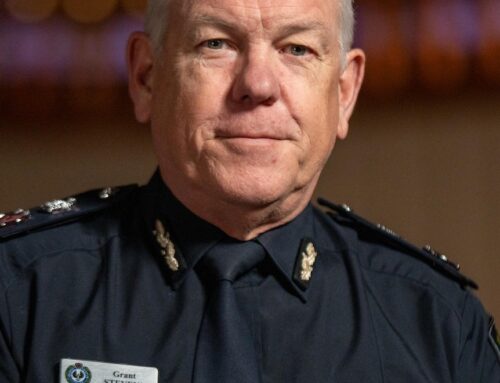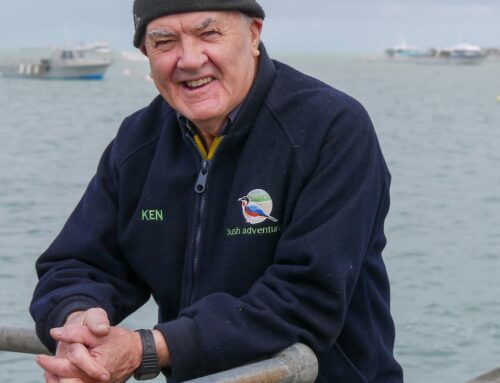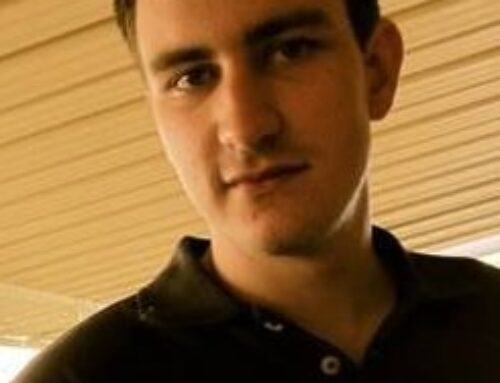Thousands of Australians and New Zealanders are gathering for Anzac Day dawn services and parades to honour those who served their countries.
This year marks 109 years since Australian and New Zealand soldiers landed on the Turkish coastline at Gallipoli during World War I.
Their eight-month battle was ultimately unsuccessful, but their courage and bravery amid hardship have become an enduring symbol of military sacrifice.
The day now honours the more than 1.5 million men and women who have served Australia in all conflicts, wars and peacekeeping operations, and the 103,000 Australians who lost their lives while serving.
Dawn services are kicking off in cities and towns across every state and territory in Australia and in Papua New Guinea, with a later service at Gallipoli at dawn local time.
‘We feel the weight of history’
The National Dawn Service at the Australian War Memorial in Canberra has wrapped up, with more than 32,000 people paying their respects.
This year’s commemorative address was delivered by Vice-Admiral David Johnston, the incoming chief of the defence force.
“We know how many Australians have died in the service of our country but we do not know how many grieve each Anzac Day. How many are grieving amongst us today?” Vice-Admiral Johnson told the service.
“I ask you all to hold in your hearts those who mourn on Anzac Day and remember those whose service left them wounded in body, mind or spirit.”
After spending two days trekking on the Kokoda Track, Prime Minister Anthony Albanese has attended a dawn service at one of the crucial battlegrounds of the Pacific in World War II.
On a cool, clear morning high in the mountains of Papua New Guinea, Mr Albanese paid tribute to the Australian and Papuan infantry, as well as the villagers, who suffered in 1942.
“We feel the weight of history as we gather here along the Kokoda Track, this great artery of mud and suffering and perseverance that has come to occupy a place of singular power in Australia’s shared memory,” he said.
At a dawn service at Adelaide’s National War Memorial, one of the centrepieces of local Anzac Day commemorations, a densely packed gathering heard messages of remembrance and mourning.
Chair of the RSL Anzac Day Committee Ian Smith spoke of the importance of continuing to pause and reflect on Anzac Day, but also of safeguarding it.
He used the sombre opportunity to reflect on the occasion’s ongoing relevance.
“The reality of war reminds us of the value of peace, and the security and prosperity that peace can bring,” Mr Smith told the gathering.
“The conflicts raging today in Ukraine and Gaza remind us that warfare is brutal, destructive and costly. It is an experience that often takes an extreme toll [on] the civilian population.
“As we pause to remember and honour the fallen, we must also guard our Anzac traditions against the heedless nationalism sometimes promoted by those who do not understand what Anzac Day is about.”
‘Everyone came down’
At the Cenotaph in Hobart, former Tasmanian soldier Mark Direen was with other men he had served with in the SAS.
His friends had travelled from interstate to be with him in Hobart on Thursday.
“We’ve got people from Western Australia, Queensland and Victoria,” he said.
“Every year we meet up in a different location and this year it was everyone’s turn to come to my house, everyone came down to Hobart.”
He said it was good to get together with fellow veterans on Anzac Day “who understand you, understand what you’ve been through in your service”.
Another onlooker in Hobart, Josh Potts, wanted to remember those from his family and the wider community who had served over the years.
He brought his daughter Natalie to her first dawn service.
“I think it’s good for the young generation to grow up and learn respect for the services,” he said.
People travel from far and wide for Sydney services
Thousands have turned out for Sydney’s official dawn service to commemorate Anzac Day 110 years after the declaration of World War 1.
Premier Chris Minns and Governor-General Margaret Beazley spoke at the 90th ceremony in Martin Place, with NSW Police Commissioner Karen Webb and Opposition Leader Mark Speakman amongst those who laid wreaths at the cenotaph.
For Brian Hemming, his first ANZAC morning in Martin Place marked an important day to remember his father, who became a prisoner of World War II in Changi.
“This is a very important day on the calendar, because it makes you proud to be Australian, and I’m proud of my father, proud of his service.”
“I got a little emotional this morning because the hymn they read was Abide With Me, that was my father’s favourite hymn. I played that at his funeral.”
Veteran Sarah Watson has served in the Australian military for 18 years, including a posting to Iraq.
She travelled from Yass Valley with her two sons George and David,to share the importance of this day with her family.
It’s the friendships she forged while serving in Iraq that are most memorable for her, but also, the impact service had on her family.
“I was married, but the issues associated with service and health battles afterwards, sort of, led to my marriage breakdown.
“So I think it’s the cost of that, you know, we have a high divorce rate in the ADF and veteran community.
“I would like all Australians to take a moment to just really remember and be grateful for the sacrifices of our men and women who have served for the freedom and great way of life we enjoy today.”
For Bronte Pollard, after serving nine years in the navy, it was the recognition of families support of veterans that stood out to him on Thursday morning.
“I hope Australians today reflect on those who served in the wars, and also remember the families and the support that those serving members need at home, so they can go about their job.”
In Sydney’s West, hundreds of people woke up to watch the sunrise and pay their respects to Australia’s service men and women at Castle Hill.
‘A new tradition’
In Queensland, thousands attended the dawn service in Brisbane which started with the traditional lowering of flags to half mast.
Queensland’s Governor Jeannette Young addressed the service before leading the wreath laying ceremony.
RSL Queensland said there’s been an increase of Anzac Day Commemoration services with more than 450 events being held across the state.
Dean Davies and Ian Withrington both served in the Australian Army at Bougainville in 1994 as peacekeepers but never met.
After spending the last four years chatting on social media and calling each other, they decided this year’s Anzac Day service in Brisbane would be the day to meet.
“This Anzac Day has started a new tradition for us” said Mr Davies.
“We were on the flight deck on the HMAS Tobruk. He was on the port side and I was on the starboard side,” said Mr Withrington.
“It’s like we’ve known each other for years”
“We’re brothers in arms — we can always count on each other.”
Thousands of people have also gathered at Currumbin Beach on the Gold Coast for Anzac Day commemorations.
It’s the largest Anzac Day service in regional Australia.
As the sun rose over the beach, there were musical performances, a parade, speeches and the burial at sea.
A gunfire breakfast, march and two-up at the Currumbin RSL will follow.
Peacekeeping remembered in Victoria
In Victoria, thousands of people have gathered at the Shrine of Remembrance in Melbourne, despite the threat of rain on Thursday morning.
This year’s dawn service in Melbourne is focusing on the work of Australian peacekeepers, which stretches back 76 years.
Victoria’s Governor Margaret Gardner told those gathered at the shrine that it was important to continue to honour those who have served their country in wartime and peacetime.
“Anzac Day matters not only because of the stories that were recorded but because of the stories that went unrecorded,” she said.
“Those who volunteered their lives and were not singled out for mention.”
“The best way to honour the sacrifices of those who have served our nation in wartime is to make every effort to promote and protect peace.”
Thousands of people made the early morning march to Geelong’s Eastern Beach foreshore on Thursday morning, packing out what is likely to be Victoria’s biggest dawn service outside of Melbourne.
Geelong RSL vice-president Matthew Jack spoke at the Eastern Beach dawn service, thanking the public for their attendance and support.
“There’s nothing worse than [when] you hear the negative side of [a] country’s sending soldiers out to war, so it’s good to see when you come back that the community is behind you,” Mr Jack said.
This year’s ANZAC Day commemorates the 25th anniversary of an Australian-led deployment to East Timor.
This morning was not the first time Mr Jack has dealt with the ABC, having been alongside a television crew in October 1999 when he and his fellow troops were fired upon in East Timor’s border town of Motaain.
ABC cameras caught the moment, and ensuing firefight and conversations between opposing forces, which appeared to show the shootout had been sparked by differing maps of the region and confusion over the location of the border.
“I was on the first plane with 2RAR (second battalion, Royal Australian Regiment) to support East Timor independence, on the 20th of September, ’99,” he said.
“We did have a war correspondent with us from the ABC in Motaain on the 10th of October, and during a gunfight the cameraman recorded the whole thing.
“We were all pretty lucky, there was people killed on the other side, but luckily, just from our training, we had no casualties.”
Posted , updated



